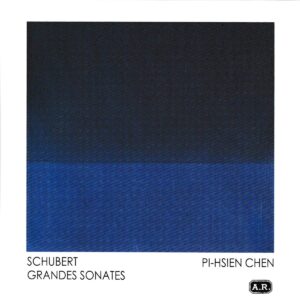Apparently it’s not enough to bring out a release simply titled “Pi-hsien Chen plays Schubert”. You’ve got to launch a veritable Pi-hsien Chen “edition” devoted to “Schubert Grandes Sonatas”. That’ll capture at least one critic’s attention. As it happens, Chen’s Schubert is mostly less than “grande”.
In the E-flat D. 568 sonata, the pianist attends to every accent, phrase marking, and distinction between detaché and legato, yet the music never flows nor takes wing. Compare her static, discontinuous first movement to the fluid and fleet accounts by Paul Badura-Skoda or Donald Isler, and you’ll hear what I mean.
The A minor D. 845 Moderato’s exposition moves in fits and starts, although Chen finds her center once the development section kicks in. After a choppy rendition of the second movement’s theme, Chen brings more shape and nuance to the variations that follow, yet without matching Mitsuko Uchida’s blazingly architectonic approach or Wilhelm Kempff’s genial grace. If the Scherzo’s dotted motive lacks Richard Goode’s ricocheting tension, the finale’s cascading perpetual motion patterns convey a lovely conversational repartee by way of Chen’s uncommon yet convincingly measured pace.
Although Chen’s tempo at D. 850’s outset rightly addresses Schubert’s Allegro vivace directive, the interpretation lacks grounding and momentum. Just what Chen is trying to express by her picky, exaggerated articulation in the slow movement is beyond my comprehension, unless she’s trying to channel Webern’s Variations Op. 27. The contrasts between the Scherzo’s jaunty dotted rhythms and lyrical rejoinders are neutralized by stiff and enervated execution.
If the C minor D. 958’s outer movements lack fire and thrust, Chen sings out the middle movements eloquently, showcasing her excellent finger legato technique with little help from the sustain pedal. But her prosaic A major D. 959 dies on the vine, except for some sensitive touches in the Rondo: too little, too late.
However, Chen’s G major D. 894 is pure gold. She holds the long first movement radiantly together with exposition repeat intact, generating an enchanting note-to-note continuity and inner glow. The pianist sets a basic fast tempo for the Andante that she modifies with the utmost flexibility, subtlety, and sensitivity. Her little caesuras and hesitations in the Scherzo are ingenuously gauged and stylistically apt. Granted, some of the Allegretto Finale’s elongated upbeats border on the prissy, yet the music’s overall mood is never violated.
The recorded ambience is full-bodied yet on the dry side. I would forgo obtaining this release’s physical three-CD incarnation, and instead download Chen’s G major sonata complete, along with that beautifully played A minor sonata finale.
































